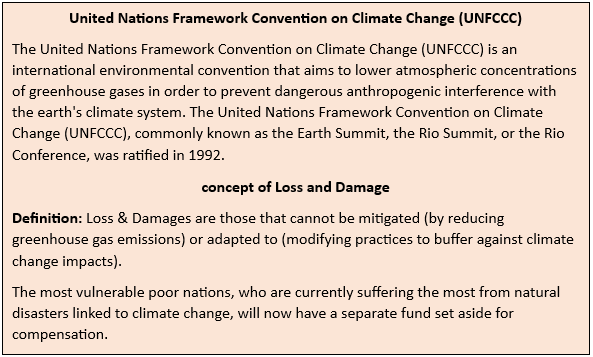- Courses
- GS Full Course 1 Year
- GS Full Course 2 Year
- GS Full Course 3 Year
- GS Full Course Till Selection
- Online Program
- GS Recorded Course
- NCERT (Recorded 500+ Hours)
- Polity Recorded Course
- Geography Recorded Course
- Economy Recorded Course
- AMAC Recorded Course
- Modern India, Post Independence & World History
- Environment Recoded Course
- Governance Recoded Course
- Science & Tech. Recoded Course
- International Relations and Internal Security Recorded Course
- Disaster Management Module Course
- Ethics Recoded Course
- Essay Recoded Course
- Current Affairs Recoded Course
- CSAT
- 5 LAYERED ARJUNA Mentorship
- Public Administration Optional
- ABOUT US
- OUR TOPPERS
- TEST SERIES
- FREE STUDY MATERIAL
- VIDEOS
- CONTACT US
LOSS AND DAMAGE IN THE SUNDARBANS
LOSS AND DAMAGE IN THE SUNDARBANS
28-09-2023
Latest Context
Recently, Indo-Bangla consensus on the need to highlight climate impact, loss & damage in Sundarbans globally.
Sundarbans
- The Sundarbans is a mangrove area in the delta region that was created by the Ganges, Brahmaputra, and Meghna rivers depositing sediment as they merged into the Bay of Bengal. It is the world's largest delta and mangrove forest.
- Sundari trees are abundant throughout the forest, which is how they got their name.
- The Sundarbans have been recognised by UNESCO as World Heritage Sites since 1987, Wetlands of International Importance under the Ramsar Convention from 2019, and Biosphere Reserves by UNESCO since 2001.
Biodiversity - Flora and Fauna in Sundarbans
- A diverse variety of plants, including trees, shrubs, grasses, epiphytes, and lianas, make up the vegetation, which is primarily mangrove in nature.
- The vegetation over here uses physiological adaptations, such as pneumatophores roots (see image below), stilt roots, aerial roots, adventitious roots, salt secretion through evapotranspiration, and viviparous mode of reproduction, to thrive in such a highly salinized and soggy region.
- In addition to 400 species of fish, the Sundarbans are home to about 50 species of mammals, 320 species of migratory and inland birds, 50 species of reptiles, 8 species of amphibians, and 50 species of reptiles.
- Royal Bengal Tigers, Estuarine Crocodiles, Spotted Deer, Barking Deer, Rhesus Macaques, Jungle Cats, Leopard Cats, Indian Porcupines, Otters, and Wild Boars are a few of the major animal species that may be found here.
- But as a result of climate change, the Sundarbans' biological landscape is constantly shifting.
How Climate Change is Affecting the Sundarbans?
- With an increase in strong cyclones, it was noticed that the transboundary Sundarbans are one of the world's climate change hotspots.
- More than twice as much sea level rise as the rest of the world is happening here.
- Diverse molluscs and crustaceans once found refuge in these mangroves, but these creatures are also going extinct as a result of these species' polluted discharges and breeding practises.
- High levels of erosion brought on by the action of the waves becoming more intense compel massive forced movement of people.
- Since there have been so many storms over the years, practically all of the rivers and ponds in the Sundarbans have become more salinized, which has decreased the productivity of farms and fishponds, further lowering the incomes of the poor and vulnerable households.
- The Indian Sundarbans are thought to have lost 210 square kilometres of land owing to sea level rise over the past six decades, and by 2050, the region would experience a rapid increase in temperature, an increase in storm frequency, and flooding.
- At least one-fourth of the eight million people who reside in and around the Sundarbans are reportedly at risk from climate-related calamities.
Recent initiatives taken by the governments of India and Bangladesh to protect the Sundarbans
- The implications of climate change on the Sundarbans should be considered a global issue, not simply a local one, according to the representatives from India and Bangladesh.
- India and Bangladesh will present a joint document at COP 28 of the UNFCCC in Dubai in December 2023 to address this issue on a global scale.
- This stage is meant to get protection funding as well as emergency assistance for loss and damage.



